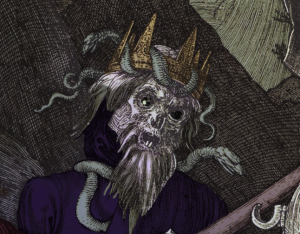One of three master engravings by Albecht Durer, The Knight, the Devil and Death (1514) depicts a complicated romance of intrigue and mystery. Just a glance at the posturing and expression of the characters allows for an easy reading of this deeply symbolic work of art.
The Knight, poised with his spear, looks not upon the Devil or Death, for he is in love with both, and he doesn’t want either of them to figure out that they’re being played.
If you look closely upon the face of the Devil, however, he does know about the Knight’s infidelity… he just doesn’t care. He phallic imagery bends and twists in all directions; he’ll stick it anywhere. Have some self respect, Devil.
Death, meanwhile, glowers naively at viewer; his pleading eyes ask all the questions. Why isn’t he looking at me? Death wonders. Doesn’t he love me anymore? Am I getting too old? One of Death’s hair snakes looks towards the knight, longingly; the other gazes away, unable to deal with the situation.

Illustration by Edmund Sullivan, for AC Farquharson’s translation of Lamotte Fouque’s “Sintram and his Companions” (1908).
Durer’s image inspired countless works of art and literature, and his depiction of the devil became a common representation of the beast. It was in the novel “Sintram and his Companions,” (1908) however, that Durer’s imagery was really explored to its full potential. The book features the characters of Sintram the Knight, Death and the Devil in sexually charged romp, with undertones that range from “subtle” to “naked dudes stabbing each other.” The frontispiece of the book (below) itself is Durer’s original print.




